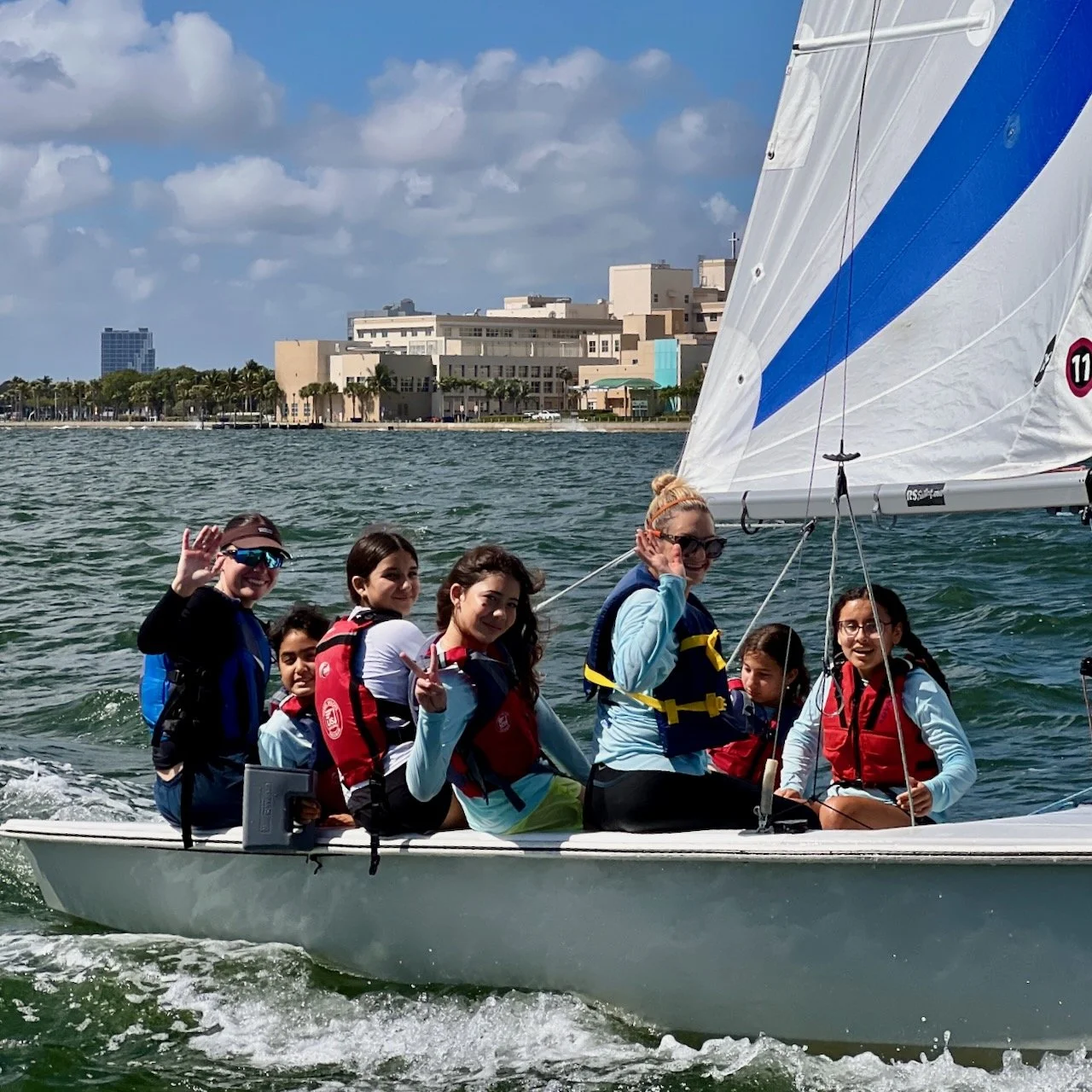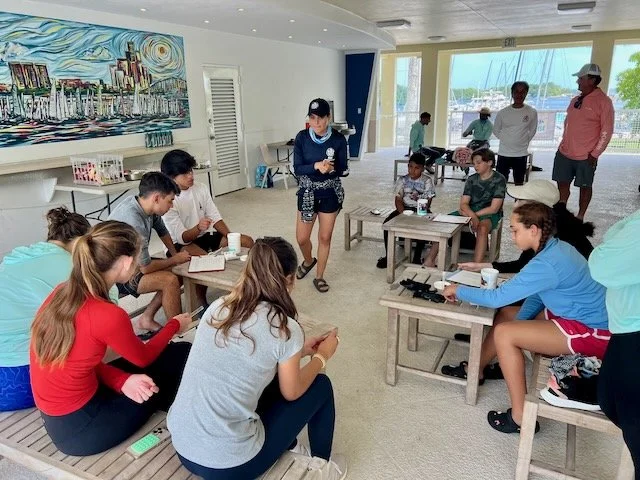It was another windy day on the Bay. The weather forecast called for Easterly wind, 20-25 knots, diminishing in the afternoon, but then picking up again in the evening. We decided to use both our RS Tera and RS Venture. The teams were divided up and assigned to our various vessels. Coach Josh did a rigging demo of the RS Tera for everyone to see. TJ and Ale were the first students to sail the new boats. I made them reef the sails by simply wrapping the sails around the mast a few times. At first, they objected to the idea, but they agreed that it might be a good idea. The reefing process took under 60 seconds to complete..
SYSTEM S9-E2
As you will see, today was a picture-perfect day. With northerly wind of 5 to 10 knots, clear skies, and even clearer water, we didn’t have to sail very far. We dropped the anchor a stone's throw away from Mercy Hospital. The sea state was flat, the wind puffy, sometimes calm, and other times windy. From here, we would try out our different equipment and enjoy one another’s company. As I was hoping, our new RS Tera was a hit! Check out Kenny, Jonathan, TJ, and Coach Josh sailing it. I bet that others will surely follow! Today qualifies as one of the best days ever! How about that?
SYSTEM S9-E1
After a month-long break, we were thrilled to welcome our students back today. Almost everyone returned for the spring session—and while we lost one student, we gained four new ones. The program is growing, and that’s always exciting.
Taking a month off might sound like a good idea, but I’m not so sure. Skills get rusty when we don’t practice regularly. Twice a week would be ideal, but for now, we’ve settled on once a week.
SYSTEM S8-E8
As usual, the day started on the second-floor breezeway and in the classroom. We then filled up our boats and headed out sailing on Biscayne Bay. Once again, we return to the Sister Banks next to the Vizcaya Museum. The NEXT LEVEL kids kept sailing the entire time, and several SYSTEM kids joined them. To sum it up, we have been saving our best for last. The picture and video below will tell the whole story.
SAILING'S FUTURE STARTS HERE
US SAILING recently announced their new tiered pathway to the US SAILING team with the Olympic development programs. We welcome the path to the podium, but let’s not forget the impact community sailing programs have on introducing learn-to-sail programs within their communities, such as Team Paradise Sailing, located in Miami, Florida.
SYSTEM S8-E7
One highlight of the day was watching Jian step into the role of mentor for Kenny as they sailed together for the first time. They looked fantastic out on the water, and their teamwork was impressive! The excitement grew when other kids noticed Kenny was set to sail in the RS Feva; everyone wanted to join in! This group is filled with extraordinary, talented, and genuinely gifted individuals!
We captured some fantastic moments, like when Kairi hiked out on the trap for the first time—check out that video….
SYSTEM S8-E6
Today, we had another small craft warning about boating on Biscayne Bay. The wind was forecasted to blow out of the Southeast 10 to 15 kn with gusts up to 20 kn, which is a little bit more than we need, but it is doable. We had a new coach joining us today. Her name is Ella, and she is an L-2 certified youth coach. Today’s STEM class was the second day of module five, water quality, testing part B. The kids were pretty excited about it. First, they were in the classroom on the second floor, then collected water samples in three different locations and tested the water in the first-floor breezeway.
SYSTEM S8-E4
Who does not want to make this a better world and place? Today, we added to our protocol. One of our coaches, who also studies marine biology, encouraged the students to pick up seagrass on her boat. She's an expert in the area and would tell them what type of seagrass it was. A minor problem was that the student didn't pick up the seagrass alone. There was also a Portuguese Man o' War in there. The student got stung badly….
SYSTEM S8-E3
Team Paradise has equipment and other components that make us unique and set us apart from similar organizations. Our Castoldi jet tender 21' is one example. It has an inboard diesel jet engine, water jet propulsion (propellerless), and a capacity of 12 people. It is our flagship! She is a workhorse that we utilize about 60 days per year. Picture us down by the docks….
SYSTEM S8-E2
Despite a challenging day, we delivered on our promises of fun and safe learning! We had thirty-four people on the water fifteen kids in the SYSTEM group, ten kids in the NEXT LEVEL, and nine volunteers participating. The weather forecast called for small craft should exercise caution. South winds, 10 to 15 kn with guts up to 20 kn a chance of showers and a slight chance of thunderstorms in the morning high tide was 12:23 PM.
SYSTEM S8-E1
The US Sailing Center is a busy place this time of the year. The US SAILING team has a training camp; there was an Etchells and Viper regatta this weekend. Add a bunch of coach boats and coaches. The good news is that our kids see all these hot, looking boats and the tremendous athletes who sail them. They act as role models for our students!
SYSTEM S7-E8
There wasn't much boat traffic today, and the wind direction and strength were perfect for sailing over to Key Biscayne. I realized we could lay Hurricane Harbor on a long port tack. The wind was supposed to increase throughout the day, making a fast reach sailing back to Coconut Grove possible. The last time we sailed to Key Biscayne was before summer camp. We always stay close because of weather, wind, and safety. When we sail across the Bay, our safety protocol includes a coach boat and the group staying close together, representing a bigger picture to alert oncoming boat traffic.
SYSTEM S7-E7
The conditions were near perfect with about 15 kn of breeze out of the east. The wind was supposed to increase, so we wanted to sail early. A few of our regular sailors were missing, but there were still 27 people out on the water, including students, coaches, and counselors. Chris filled in for Josh, coaching the Next Level sailors using the Boston Whaler. We had both our RS Ventures out there looking good. The rest of us were in our propeller-less safety boat. Our system sailors started in the classroom with module six, which was about marine debris.
SYSTEM S7-E6
When learning a new sport, playing with someone more skilled than you is always beneficial. Today, we had the opportunity to do just that. Josh brought along Chris, a student at the University of Miami. Chris sailed with Adrian, and they took turns as skipper and crew. I was impressed with Adrian's performance; he looked fantastic out there. Everyone looked great except for me. I was driving the safety boat and trying to film a video simultaneously, but I didn’t realize my phone was set to the wrong mode. What I thought would be a video turned out to be just a picture. It's okay, though—I’ll do better next weekend.
SYSTEM S7-E5
Sailing can be compared to a simple machine in several ways. Like a simple machine, sailing utilizes fundamental principles to accomplish work. For example, the sail on a boat can be likened to an inclined plane or a wing, using the force of the wind to propel the boat forward. The rudder can be likened to a lever, changing the boat's direction by applying force at a certain point. In this way, sailing shares similarities with simple machines by utilizing fundamental principles to achieve a specific purpose.
SYSTEM S7-E4
What is remarkable is when teaching moments appear out of nowhere in real-time, like turning something that most people would experience as unfavorable into a positive experience. It's not always easy because, as always, the timing has to be correct.
The weather forecast was a bit "iffy " this morning. One parent contacted us, saying, "The weather is bad now. Are we still on for today?" I responded, "We will have a morning briefing and a chalk talk, and then hopefully go sailing."
SYSTEM S7-E3
Today was special. It felt like the first day of the fall season. The air temperature was perfect, with low humidity and the perfect breeze for what we wanted to accomplish. It was a beautiful day. The next-level sailors took off into the bay with coach Josh. Our SYSTEM sailors stayed closer to shore. We followed them until we had the perfect picture of the two RS Ventures. Then, we sought more shallow waters for the water comfort test three of the new kids had to perform. It was all good. We moved even closer to the port and dropped the anchor again. This is where all of the boats eventually would meet up. The foam mattress was rolled out, and everyone seemed to enjoy it themselves. The pictures and video below will tell you more about our day...
SYSTEM S7-E2
The more we do it, the better we get! Today was the second of eight lessons in our fall session of Youth Sailing. Each Saturday will look the same. We are divided into two groups: the beginner sailors, ages 9-12, who attend our STEM class, the SYSTEM, and the intermediate sailors, ages 12-17, who attend our NEXT LEVEL program. Both groups began at 10 AM and finished at 3 PM. The SYSTEM classroom is indoors, and the NEXT LEVEL meets in the second-floor breezeway. The SYSTEM is based on REACH (US Sailing's STEM education series), while the NEXT LEVEL is based on US Sailing's Intermediate curriculum.
SYSTEM S7-E1
The Team Paradise “SYSTEM” (Sailing + Youth + STEM) program has launched! We will measure the wind, test water quality, analyze marine debris, observe marine life, learn geometry and how to sail, and have so much fun! Biscayne Bay is the perfect classroom for our sailors to take their STEM experiments out on the water.
For our first class we learned about and observed the wind, then took what we learned out on the water and took a little time to splash around and get to know each other better!
Spring Break with the Miami Waterkeeper
During spring break, we took a day to introduce our Sailing + Youth + STEM (“SYSTEM”) initiative. Partnering with the Miami Waterkeeper organization, we had student-sailors, coaches, and three graduates from the University of Miami's Rosenstiel School of Marine and Atmospheric Science participating in the class. We began the day with a presentation on water quality monitoring.
























